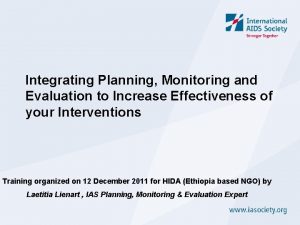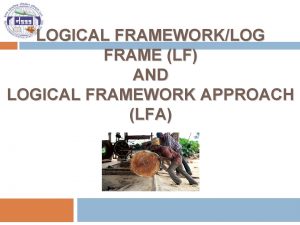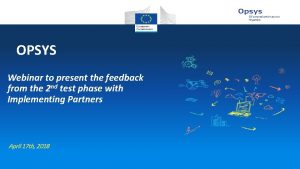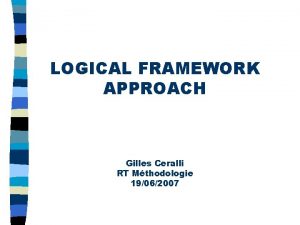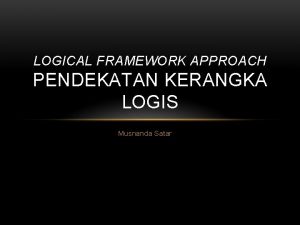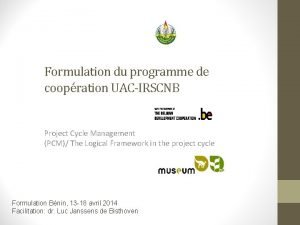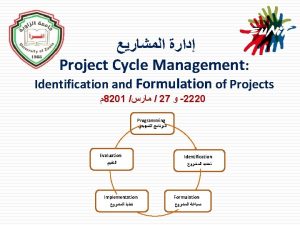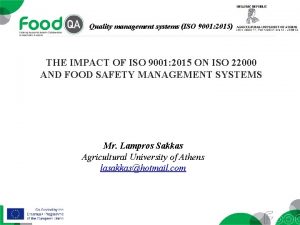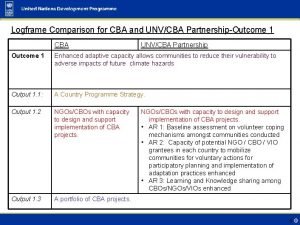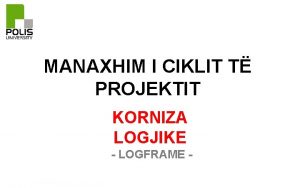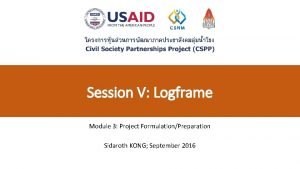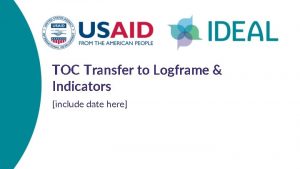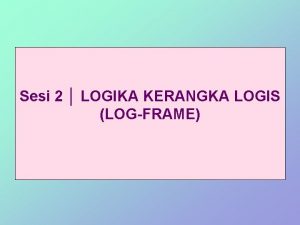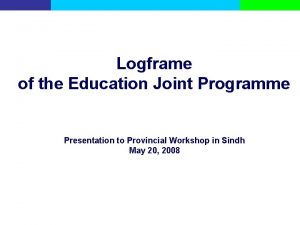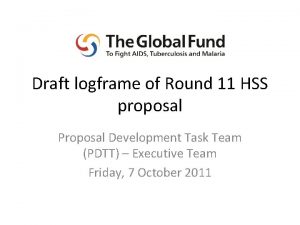MAIN CHANGES TO LOGFRAME TEMPLATE PRAG 2015 PRAG








- Slides: 8

MAIN CHANGES TO LOGFRAME TEMPLATE – PRAG 2015 / PRAG 2016 Based on: CONCORD Guidance Notes on Application forms London, November 16 th, 2016

INTRODUCTION/BACKGROUND In the PRAG 2015, an amended version of the logical framework was introduced for quality assurance (need for quality and simplification) DEVCO was probably inspired by DFID and introduced results chain terminology. Aim is to foster its use as flexible tool for monitoring performance - not only during the proposal design preparation, but also during the implementation and the evaluation of the action. APPLICANTS ARE NOW EXPECTED TO SEND THE UPDATED LOGICAL FRAMEWORK WITH THEIR REPORTS TO THE DONOR

MAIN CHANGES Objectively verifiable indicators (OVIs) have been separated into their component elements (Indicators, Baseline, Current value, Targets) Expected results are replaced by intermediary outcomes. The LF now includes outputs as “the direct/tangible outputs (infrastructure, goods and services) delivered by the project” Then overall objective is IMPACT, specific objective/s become OUTCOME/S, activities remain activities PROBLEM: In some calls (which still use the PRAG 2015 templates), inconsistent terminology between concept note (still referring to expected results) and LF (referring to outputs)

HOW TO DEAL WITH THESE CHANGES? As for the LF, no clear guidance from DEVCO as to what is optional vs. mandatory to fill in at the proposal stage and what is required to complete at the reporting stage Initially, DEVCO explained that in the baseline column, applicants were not requested to fill in the information if the baseline was one of the (initial) activities of the proposed action. BUT: more recently, Desk Officers have encouraged organisations to fill in the logical framework to the maximum extent possible

MAIN RECOMMENDATIONS Have only one specific objective which will be the main outcome of the project, (unless the project is a large/complex one) Include expected results as intermediary outcomes. Develop outputs (per each intermediary outcome) as the direct products of the activities*. * N. B. : In CONCORD guidance notes, they seem to suggest that expected results should be included as outputs! Where possible, complete baseline data for project (this can be changed at implementation, e. g. in interim report with explanation).

MAIN RECOMMENDATIONS (CONT’ED) If baseline is to be conducted in the first months of the action, mention it clearly in the logical framework (and the narrative!). Current value is to be filled during interim and final reports (not necessarily every year!) In case of doubt, DEVCO recommends applicants to ask clarifications to the Unit in charge of the call – SUBMIT QUESTIONS!

THANKS! LET’S HEAR FROM YOU NOW…

Results chain main changes Overall objective: Impact The broader, long-term change which will stem from the project and a number of interventions by other partners. Outcome = Oc Outcome(s) Specific objective(s): Measure the long-term change to which the project contributes. Baseline Current value Targets (incl. reference year) Reference date (incl. reference year) Ideally, to be drawn from the partner's strategy Sources and means of verification Assumptions Ideally, to be drawn from the partner's strategy To be drawn from the partner's strategy. The intended value of the indicators. Sources of information and methods used to collect and report (including who and when/how frequently). Factors outside project management's control that may impact on the outcome-impact linkage. Idem as above for the corresponding indicators. Idem as above for the corresponding indicator. Factors outside project management's control that may impact on the output-outcome linkage. To be presented disaggregated by sex. The direct effects of the project which will be obtained at medium term and which tend to focus on the changes in behaviour resulting from project Measure the change in factors determining the outcome(s). The starting point or current value of the indicators. The value of the indicator at the indicated date To be presented disaggregated by sex (possibly) intermediary Outcome = i. Oc The direct/tangible outputs (infrastructure, goods and services) delivered by the project. Measure the degree of delivery of the outputs. Output = Op To be presented disaggregated by sex. Op 1. 1. (related to Oc 1) Op 1. 2. (related to Oc 1) (…) Outputs Indicators Op 2. 1. (related to Oc 2) (…) Idem as above for the corresponding indicators.
